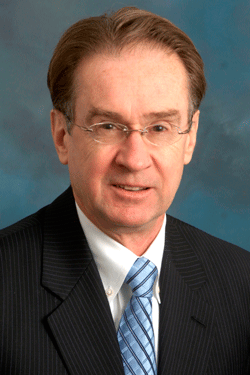National Physical Activity Plan calls on communities to get Americans moving
May 4, 2010

Russ Pate
A National Physical Activity Plan, released Monday (May 3) in Washington, D.C., is a call to action for communities to help Americans move more and improve their health.
The Arnold School of Public Health at the University of South Carolina played a critical role in the creation of the plan, unveiled at the National Press Club.
Arnold School exercise science professor Dr. Russ Pate, who led the coordinating committee that developed the plan, spoke at the news conference, along with Robin Ikeda, a deputy director at the Centers for Disease Control and Prevention; Barry Ford, National Coalition for Promoting Physical Activity; Nancy Brown, American Heart Association; and Dr. Robert Sallis, past president of the American College of Sports Medicine.
Pate, internationally recognized for his research on the link between physical activity and health, said the plan complements the 2008 Federal Physical Activity Guidelines, which set specific physical activity goals for children, teens, adults, and people with disabilities.
“The major message of the national plan is that we must change our communities so that Americans will be able to meet the physical activity guidelines,” said Pate.
Arnold School professor Dr. Steve Blair, the senior scientific editor on the Surgeon General’s Report of Physical Activity and Health, also served on the coordinating committee that included research assistant Dan Bornstein, a Ph.D. student in the Department of Exercise Science.
“The National Physical Activity Plan calls for changes in the places where we live, work, play, and go to school so that people can meet those guidelines,” he said. “There are reasons why we are not more active. We are not going to be able to turn back the clock to the 1950s when children and adults had more activity in their lives. We are going to have to make changes in our neighborhoods, schools, workplaces and communities to help people be more active.”
The plan comprises the recommendations of many of the nation’s leading physical activity, medical, health and advocacy organizations, including the Centers of Disease Control and Prevention, the American Medical Association, the American College of Sports Medicine, the American Academy of Pediatrics, the American Dietetic Association, AARP, and others. More than two years in the making, the plan calls for communities, schools, government agencies, public policy groups, media, and other organizations to develop strategies that will help communities find ways to put Americans on the road to improved fitness.
“There’s no magic bullet,” Pate said of the effort needed to improve the public’s health through increased physical activity.
The plan calls for eight key sectors to be involved in implementing the plan: public health; education; volunteer and non-profit organizations; transportation, urban design, and community planning; mass media; healthcare; business and industry; and parks, recreation, fitness and sports.
To ensure that the National Physical Activity Plan doesn’t become just another report on the shelf, the Coordinating Committee will continue to meet and make changes to keep the plan updated with changes and new recommendations, Pate said.
The National Coalition for Promoting Physical Activity will assume responsibility for implementing the plan.
“Over the past 20 years, the decline in activity is visibly affecting us and our youth. The impact on our health from sedentary lifestyles and other unhealthy behaviors has heightened our goal of reversing this decline,” he said.
Visit physicalactivityplan.org to learn more about the plan, which also is highlighted in an article in USA TODAY: www.usatoday.com/news/health/weightloss.



_01.jpg)
_02.jpg)